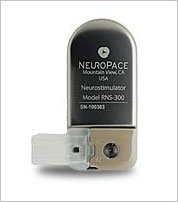A new device for epilepsy patients being developed by Mountain View, CA-based NeuroPace was featured this week in Technology Review. The company’s responsive neurostimulation (RNS) system is designed to help epilepsy patients who are unresponsive to drugs. NeuroPace estimates that about 2.5 million Americas are affected by epilepsy, and roughly 40-50% of those are either unresponsive to medications or experience intolerable side effects.
Implanted in the skull, the RNS device detects abnormal electrical activity in the brain and responds by delivering electrical stimulation to normalize brain activity before the patient experiences seizure symptoms.
“The idea is to stop the seizure before it occurs,” NeuroPace CEO Frank Fischer tells Technology Review.
The article points out that privately held NeuroPace is not the first company to experiment with using electricity to treat neurological disorders. Cyberonics‘ Vagus Nerve Stimulator, for example, is implanted under the skin near the collarbone and connected through a wire to the vagus nerve in the neck; electrical signals travel along the nerve to the brain at regular intervals. Medtronic also is in the game with an implantable electrode that’s currently approved for Parkinson’s and in trials for use in epilepsy patients.
NeuroPace’s device might have an edge, however, because the electrical pulses delivered by RNS are not continuous; they’re only released when the device senses abnormal brain activity. Nor does RNS cause hoarseness in patients, a common side effect of the Vagus Nerve Stimulator.